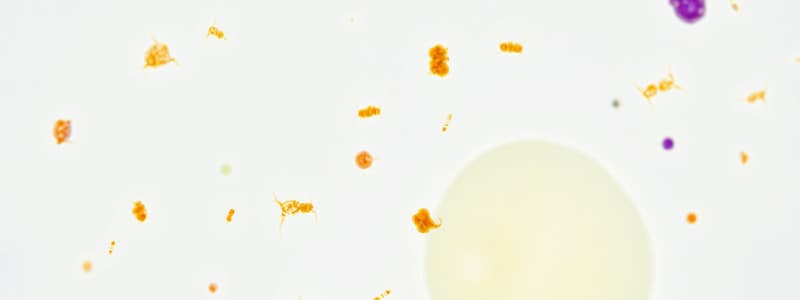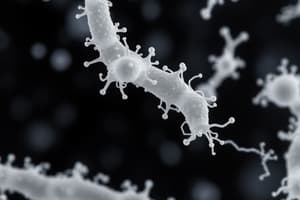Podcast
Questions and Answers
What distinguishes signs from symptoms in medical diagnostics?
What distinguishes signs from symptoms in medical diagnostics?
- Symptoms can be measured chemically, but signs cannot.
- Signs are always subjective while symptoms are objective.
- Signs are objective and measurable, whereas symptoms are subjective experiences. (correct)
- Both signs and symptoms are observable characteristics.
What is the main purpose of culture media in microbiology?
What is the main purpose of culture media in microbiology?
- To provide a controlled environment conducive to microbial growth. (correct)
- To enhance the visibility of microbes.
- To eliminate harmful microbes.
- To identify specific pathogens.
Which type of media is specifically designed to inhibit the growth of some microbes while promoting others?
Which type of media is specifically designed to inhibit the growth of some microbes while promoting others?
- General-purpose media.
- Differential media.
- Enriched media.
- Selective media. (correct)
What distinguishes enriched media from general-purpose media?
What distinguishes enriched media from general-purpose media?
What type of agar contains a low pH to selectively allow certain microbes to grow?
What type of agar contains a low pH to selectively allow certain microbes to grow?
Which characteristic is true for solid culture media?
Which characteristic is true for solid culture media?
Which media type is best suited for distinguishing between different microbial species based on visible reactions?
Which media type is best suited for distinguishing between different microbial species based on visible reactions?
What is an example of a selective medium that encourages the growth of fungi?
What is an example of a selective medium that encourages the growth of fungi?
Which of the following best describes a characteristic of liquid media?
Which of the following best describes a characteristic of liquid media?
Which factor is NOT typically considered in a patient's history when diagnosing an infection?
Which factor is NOT typically considered in a patient's history when diagnosing an infection?
What does Urea broth help to identify?
What does Urea broth help to identify?
Which type of hemolysis results in clear halos around bacterial growth on blood agar?
Which type of hemolysis results in clear halos around bacterial growth on blood agar?
What is the primary purpose of Mannitol Salt Agar?
What is the primary purpose of Mannitol Salt Agar?
What color represents a Gram-negative bacteria after a Gram stain?
What color represents a Gram-negative bacteria after a Gram stain?
Which of the following is not a step in the differential staining process?
Which of the following is not a step in the differential staining process?
What is a common arrangement of cocci bacteria?
What is a common arrangement of cocci bacteria?
Which staining method uses safranin as a counterstain?
Which staining method uses safranin as a counterstain?
What effect does high salt concentration have on Mannitol Salt Agar?
What effect does high salt concentration have on Mannitol Salt Agar?
In a Gram stain, what role does iodine serve?
In a Gram stain, what role does iodine serve?
What type of media is blood agar classified as?
What type of media is blood agar classified as?
Match the following types of media with their characteristics:
Match the following types of media with their characteristics:
Match the following types of media with their examples:
Match the following types of media with their examples:
Match the following types of culture media with their purposes:
Match the following types of culture media with their purposes:
Match the following examples to the type of microbe they selectively isolate:
Match the following examples to the type of microbe they selectively isolate:
Match the following characteristics of media types:
Match the following characteristics of media types:
Match the following factors in identifying a microbe:
Match the following factors in identifying a microbe:
Match the following descriptions to the types of staining methods:
Match the following descriptions to the types of staining methods:
Match the following microbial growth conditions with their types:
Match the following microbial growth conditions with their types:
Match the following types of hemolysis with their descriptions:
Match the following types of hemolysis with their descriptions:
Match the types of media with their characteristics:
Match the types of media with their characteristics:
Match the steps of the Gram stain process with their order:
Match the steps of the Gram stain process with their order:
Match the bacterial arrangements with their definitions:
Match the bacterial arrangements with their definitions:
Match the bacterial shapes with their names:
Match the bacterial shapes with their names:
Match the differential media examples with their descriptions:
Match the differential media examples with their descriptions:
Match the Gram reaction colors with their meanings:
Match the Gram reaction colors with their meanings:
Match the types of differential staining with their functions:
Match the types of differential staining with their functions:
Match the following differential media with their specific functions:
Match the following differential media with their specific functions:
Match the descriptions to their corresponding differential media:
Match the descriptions to their corresponding differential media:
Flashcards are hidden until you start studying
Study Notes
Identifying Microbes
- Signs and symptoms can sometimes be used to diagnose a microbe or infection.
- Signs are objective and measurable, like fever or rash.
- Symptoms are subjective and describe a person's feelings or sensations, like pain or fatigue.
Patient History and Public Health
- Patient information, such as age, job, medical history, vaccination status, and current outbreaks, can help identify a microbe or infection.
Culture Media
- Provides nutrients and the right environment for microbes to grow.
- Can be solid, liquid, or semi-solid.
- Solid media contains agar for solidification, allowing for colonies to grow on the surface or be stabbed into the agar.
- Liquid media shows growth as turbidity, with no visible colonies.
General-Purpose Media
- Contains a mixture of nutrients to grow a wide range of microbes.
- Examples include nutrient broth/agar and trypticase soy broth/agar.
Enriched Media
- Contains additional complex organic substances like blood, serum, or growth factors.
- Used to grow fastidious microbes.
- Examples include blood agar and chocolate agar.
Selective Media
- Contains substances that inhibit the growth of certain microbes, selecting for the growth of specific ones.
- Helps isolate certain microbes from a mixed culture.
- Examples include mStaph Broth (high salt concentration selects for halotolerant microbes) and Sabouraud's Agar (low pH inhibits bacterial growth, selecting for fungus).
Differential Media
- Allows several types of microbes to grow but distinguishes between them through visible differences.
- Helps identify microbes by differentiating them based on their growth characteristics.
- Examples include urea broth (pH indicator differentiates microbes based on urease enzyme presence), and Chromagar (different dyes turn bacterial colonies specific colors to identify urinary pathogens).
Blood Agar
- Enriched media containing blood to support the growth of fastidious microbes.
- Differential media as it shows hemolysis patterns (how microbes affect blood).
- Alpha hemolysis: incomplete lysis, brownish-green halos around growth.
- Beta hemolysis: complete lysis, clear halos around growth.
- Gamma hemolysis: no lysis, growth doesn't affect the blood.
Mannitol Salt Agar (MSA)
- Both selective and differential media.
- High salt concentration (selective) for halotolerant microbes.
- Mannitol and pH indicator (differential), where mannitol fermenters turn media yellow and non-fermenters leave it pink.
Differential Staining
- Uses two dyes to differentiate between cell types or parts.
- Steps:
- Make a heat-fixed smear.
- Primary stain.
- Mordant.
- Decolorizer.
- Secondary or counterstain.
Bacterial Cell Shapes
- Coccus (cocci): spherical.
- Bacillus (bacilli): rod-shaped.
- Vibrio: comma-shaped.
- Spirillum: spiral-shaped.
- Spirochete: long, helical, flexible.
Bacterial Arrangements
- Single: individual cells.
- Diplo: pairs.
- Strepto: chains.
- Tetrad: groups of four.
- Sarcina: cube-like groups of eight.
- Staphylo: clusters.
Gram Stain (Differential Stain)
-
Uses four steps to differentiate bacteria based on cell wall structure.
-
Starts with a heat-fixed smear.
-
Steps:
- Primary stain: Crystal Violet.
- Mordant: Iodine.
- Decolorizer: Ethanol.
- Counterstain: Safranin.
-
Interpretation:
- Purple: Gram-positive bacteria (thick peptidoglycan layer retains the crystal violet stain).
- Pink: Gram-negative bacteria (thin peptidoglycan layer allows the stain to be washed away during decolorization, so the counterstain safranin is visible).
Ways to Identify a Microbe
- Signs are objective, measurable, and observable characteristics, such as fever or rash.
- Symptoms are subjective, feelings or sensations a person has, such as pain or fatigue.
- Epidemiology involves factors like patient's age, job, medical history, vaccination status, current outbreaks in the area, and risk factors specific to the location and/or patient's background.
Culture Media
- Purpose: Provide the nutrients and environment needed for microbial growth.
- Solid Media: Contains agar as a solidifying ingredient, allowing colonies to grow on the surface and/or be stabbed down into the agar.
- Liquid Media: Identified by turbidity (cloudiness), no colonies are present, and bacteria grow in the liquid.
Types of Culture Media
- General-Purpose Media: Contains a mix of nutrients designed to grow a broad range of microbes. Examples: Nutrient Broth/Agar, Trypticase Soy Broth/Agar.
- Enriched Media: Contains additional complex organic substances like blood, serum, and growth factors, required for growing fastidious microbes. Examples: Blood Agar, Chocolate Agar.
- Selective Media: Contains something to inhibit the growth of some microbes, selecting for the growth of specific ones. Helps to isolate a microbe from a mixed culture. Examples: mStaph Broth (high salt concentration for halotolerant microbes), Sabouraud’s Agar (low pH for fungus growth).
- Differential Media: Allows several types of microbes to grow but shows a visible difference between them, differentiating between growing microbes and aiding in identification. Examples: Urea broth (pH indicator for urease-producing microbes), Chromagar (dyes that turn colonies distinct colors for urinary pathogen identification).
Blood Agar: Enriched and Differential
- Enriched with blood, allowing fastidious microbes to grow.
- Differential due to hemolysis:
- Alpha hemolysis: incomplete lysis (brownish green halos around growth).
- Beta hemolysis: complete lysis (clear halos around growth).
- Gamma hemolysis: no lysis (growth doesn’t affect the blood).
Mannitol Salt Agar: Selective and Differential
- Selective: High salt concentration allows only halotolerant microbes to grow.
- Differential: Mannitol fermenters turn the media yellow, while non-fermenters keep the media pink.
Differential Staining: Gram Stain
- Purpose: Uses two dyes to differentiate between cell types or parts.
- Steps:
- Heat-fixed smear.
- Primary stain: Crystal Violet.
- Mordant: Iodine.
- Decolorizer: Ethanol.
- Counterstain: Safranin.
- Interpretation:
- Purple: Gram Positive.
- Pink: Gram Negative.
Bacterial Cell Shapes and Arrangements
- Shapes: Coccus (cocci), Bacillus (bacilli), Vibrio, Spirillum, Spirochete.
- Arrangements: Single, Diplo, Strepto, Tetrad, Sarcina, Staphylo.
Studying That Suits You
Use AI to generate personalized quizzes and flashcards to suit your learning preferences.




